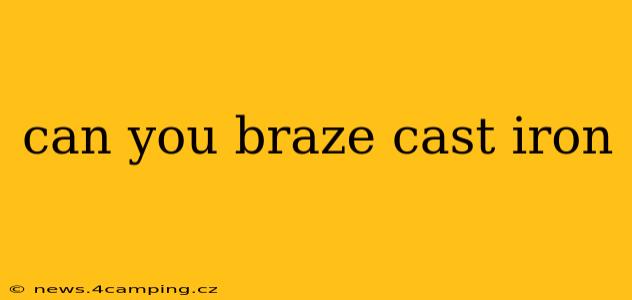Can You Braze Cast Iron? A Comprehensive Guide
Brazing cast iron is a question that sparks considerable debate among metalworkers. The short answer is: it's possible, but challenging and not always ideal. The success depends heavily on the type of cast iron, the brazing process used, and the skill of the person performing the operation. Let's delve into the specifics.
What is Brazing?
Before we explore the feasibility of brazing cast iron, let's clarify what brazing is. Brazing is a joining process that uses a filler metal with a melting point above 450°C (842°F) but below the melting point of the base metals being joined. The filler metal flows into the joint by capillary action, creating a strong bond. This differs from soldering, which uses a lower-melting-point filler metal, and welding, which melts the base metals themselves.
Why Brazing Cast Iron Can Be Difficult
Cast iron's inherent porosity and relatively low melting point present significant challenges to brazing:
- Porosity: Cast iron often contains tiny pores that can absorb the brazing filler metal, preventing proper capillary action and weakening the joint. This makes achieving a strong, reliable braze more difficult.
- Oxidation: Cast iron readily oxidizes, forming a layer of iron oxide (rust) that can prevent the brazing filler metal from properly wetting and adhering to the base metal. Thorough cleaning and pre-brazing preparation are crucial.
- Heat Sensitivity: Cast iron's relatively low melting point means that excessive heat during brazing can damage or even melt the cast iron itself. Careful control of the brazing temperature is essential.
What Type of Brazing is Suitable?
While not impossible, brazing cast iron requires specific techniques and materials. Furnace brazing is generally preferred over torch brazing because it offers better temperature control and a more even heat distribution. This minimizes the risk of localized overheating and damage to the cast iron.
What Filler Metal Should I Use?
The choice of filler metal is critical. Nickel-based brazing alloys are commonly used for brazing cast iron due to their excellent fluidity and ability to wet the surface effectively even in the presence of some oxidation. However, the specific alloy will depend on the application and the desired joint strength.
How to Prepare Cast Iron for Brazing
Proper preparation is paramount for successful brazing:
- Cleaning: Thoroughly clean the surfaces to be joined. This involves removing any rust, scale, grease, or other contaminants. Mechanical cleaning methods, such as grinding or wire brushing, are often necessary.
- Fluxing: Applying a suitable flux is crucial to remove oxides and prevent further oxidation during the brazing process. The flux helps the filler metal flow smoothly into the joint.
H2: Can you braze cast iron to steel?
Yes, you can braze cast iron to steel, but the same challenges apply. Careful surface preparation, appropriate filler metal selection, and precise temperature control are essential to ensure a successful and durable joint. The differences in thermal expansion between cast iron and steel can also be a factor, so the design of the joint should account for this.
H2: What is the best way to join cast iron?
While brazing is an option, other methods often provide better results for joining cast iron, including:
- Welding: Welding provides the strongest joint but requires specialized skills and equipment.
- Bolting/Screwing: This is a simple and effective method for many applications, especially when dealing with thicker sections.
- Epoxy: For less demanding applications, strong epoxy adhesives can provide a sufficient bond.
The "best" method depends on the specific application, the required strength of the joint, and the available resources.
Conclusion
Brazing cast iron is achievable with the right techniques, materials, and careful execution. However, due to the inherent challenges, it's often not the most practical or reliable method for joining cast iron. Other joining methods may be preferable depending on the specific requirements of the application. Always prioritize safety and use appropriate personal protective equipment when working with high temperatures and potentially hazardous materials.
